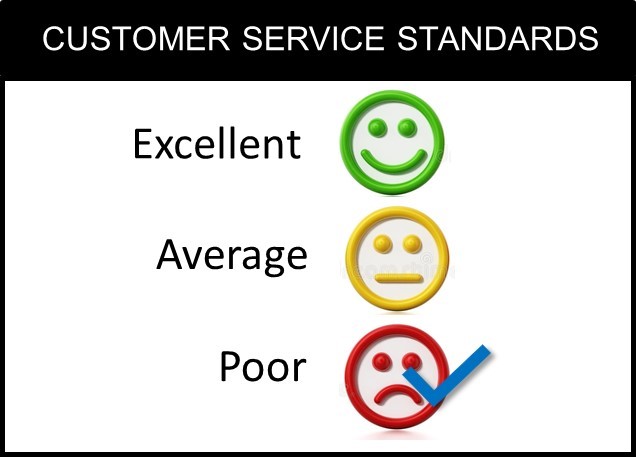
PUTTING CITIZENS FIRST
Imagine if your local area had only one supermarket, one jeweller, and one bank. Without competition, the supermarket would have no incentive to lower prices, the jeweller would have no reason to offer a broad range, and the bank would have no motivation to provide outstanding service.
Competition is about price, selection, and service. It benefits consumers by keeping prices low, delivering product variety, and raising service standards. Robust competition also compels businesses to fight for customers by meeting needs, solving problems, and adding value.
In a free market economy, it is the consumer who decides which products and services succeed and which ones fail. We are all free to choose where to shop and what to buy and – if we are not satisfied with a service provider – we can vote with our feet and take our business elsewhere.
Unfortunately, choice does not exist when it comes to government departments and agencies. Governments are monopoly providers of their services which means that they have no direct competitors. Nor do they have any need to worry about disruptive start-ups stealing their customers.
This is ironic as competition is acknowledged by governments the world over as the best available tool for promoting consumer well-being. Competition keeps businesses on their toes and pushes them to be the best, however, no such force is exerted on governments.
We live in a world where people expect fast and efficient service – it doesn’t matter whether it’s a shop, restaurant, or government agency. Yet agencies have fallen behind the customer experience curve and need to move from a government-centric to a citizen-centric service model.
Unsurprisingly, governments at all levels claim that they are customer centric, even though many citizens would argue otherwise. This is certainly the case when it comes to online services and the inability of many government agencies and departments to deliver a seamless digital customer experience.
Today, we can use online channels to order our groceries, pay our bills, and even consult our doctor. All of these interactions with the private sector are frictionless offerings and none require us to leave home. Businesses have worked hard to be in sync with customers’ digital expectations.
In contrast, the public (government) sector, lags behind leading companies in offering citizens what they want and need online. People are still required to deal with cumbersome forms and manual processes as government requirements are designed to fit agency silos and not citizen needs.
A personal example will help here. During the pandemic in early 2021, I uploaded some proof of identity documents (including a passport) to both a NSW Government agency and a Federal Government agency in support of my application to be appointed a volunteer ethics teacher at my local school.
To my delight, the Federal Government’s application process was able to be fully completed online. In contrast, the NSW Government’s process ended by requesting that I visit a Service NSW centre to submit for inspection the originals of the documents that I had just submitted online.
So, a few days later, I drove to my nearest Service NSW location and produced the relevant documents. It took merely seconds for the customer service officer (CSO) to verify each identity document. Yet, for me, the process – from leaving home, to signing in, to queueing, and then returning home again – took over an hour.
When I asked the CSO why the state government required me to present the original identity documents over-the-counter while the federal government has no such requirement, I was unhelpfully told “because it’s policy”. This lack of consistency between screening agencies is frustrating but not uncommon.
In Australia and around the world, each level of government (federal, state, and local) marches to the beat of its own drum resulting in a lack of integration and coordination between agencies. Consequently, the synchronised delivery of frontline services is obstructed.
My wife experienced this silo-mentality when she asked the same CSO (who I mentioned above) to arrange for a copy of our marriage certificate in support of her application for a NSW photo identification card. He responded by informing Beverley that she would need to apply to the NSW Registry of Births, Deaths, and Marriages for the certificate.
So, Beverley went home and applied online for the marriage certificate which was posted to her around four weeks later. I then drove my wife back to Service NSW in order for her to furnish them with the marriage certificate that she had just received in the post from the NSW Registry of Births, Deaths, and Marriages.
That Service NSW is not a one-stop access point for all state government services and transactions is another example of governments lagging behind private enterprise. Working across functional silos and agencies rather than within them means that citizens are not enjoying streamlined services.
Governments and their agencies need to urgently lift their game in mapping the complete end-to-end customer experience journey. When dealing with the public sector, such journeys can be long as they stretch across multiple agencies, channels, and touchpoints.
To simplify customer journeys, governments must harness data and technology to become more efficient and effective. Furthermore, governments need to develop a single view of the citizen-customer and put in place a safe and secure public sector data sharing ecosystem.
A further drawback with government monopolies concerns innovation. The free market is an innovation machine which has delivered untold benefits to humanity. These mind-blowing advances have revolutionised the way we live and work and provided us with access to goods from around the world.
Meanwhile, not much has changed in many parts of the public sector. In a world where same-day delivery of goods and same-day approval of loans is commonplace, it is unacceptable that you have to wait up to four weeks to obtain a copy of a simple marriage certificate.
While competition forces private enterprises to continually innovate to gain and maintain customers and achieve faster delivery times, a lack of competition in the provision of say, marriage certificates, provides no incentive for governments to innovate in order to achieve quicker turnaround times.
Governments everywhere worry about the misuse of monopoly powers and the gobbling up of competitors. That’s why regulators, in all markets, like to see competition as this gives consumers choice. Having one dominant player is frowned upon, yet governments occupy this privileged position.
According to one Australian academic, state-owned enterprises do not act in the interest of the general public. Rather, they respond to their own interests and the interests of the government that owns them. As adjuncts of the state, government agencies largely operate free from normal competitive pressures.
■ ■ ■
I acknowledge that some government monopolies – such as critical services like public transport and public healthcare – need to exist. These services must be available to everyone and not subject to market forces or the ability to pay. Regardless, no government monopoly should provide substandard service.
The absence of vigorous rivalry and the existence of barriers to entry should not be used by governments and their agencies to provide outputs which are below those available in the private sector. Just because a citizen cannot switch to an alternative source of supply does not mean that a particular government service should not be subject to continuous improvement.
An online article published by consulting firm Deloitte – which highlighted the dissatisfaction of American citizens with the service provided by the US Federal Government – should resonate with Australian governments. To improve satisfaction, the article recommended that:
… what agencies need is a transformative breakthrough that delivers radical government customer service improvement. Agencies need to rethink their approach to customers, or even who their customers are. Agencies may need to reorganize to better deliver a leading customer experience and respond to customer needs and think beyond their walls to consider the range of stakeholders that can help reimagine the customer experience.
Around the world, there are stark differences between people’s service experiences as customers of private enterprises and their service experiences as customers of government agencies. It is incumbent on all governments to close this gap in service and to meet the rising expectations of citizens. Embedding a citizen-first mindset in the public sector would be a good first step.
Consumers win when businesses compete.
Regards
Paul J. Thomas
Chief Executive Officer
Ductus Consulting


Hi Paul,
Thank you for this very well written article. You covered all the key points.
This way of running a govt department is all too common. In Canada, we have the same issues. Often it is the luck of the draw as to who will answer when we call a department. Some of the agents are helping, but often they are dismissive and/or not very empathetic, as in we do not care, this is how it is.
Now a thought….there are many retired people with immense business knowledge and expertise like yourself. Can a think tank of all these people come together as an advisory committee. Maybe your local MP would be interested to hear the ideas and recommendations brought forth. Might, get him reelected:).
Well, Paul send your email to your local govt. Mayor, and the Feds.
Thanks for your thoughts.
Cheers,
Denise
Is an Airline a government agency even though it’s been privatised but still receiving huge government subsidies?
Asking for a friend😁
Thanks Andrew,
Hmm? An interesting question. As long as the privatised airline is subject to vigorous, open market competition, then its value proposition must hold its own against competitor airlines (whether or not it is considered to be a government agency). Cheers Paul
Dear Paul,
I am always fascinated in how you select your topics for analysis and comment. They are invariably pertinent to extant issues and make a great read.
No less interesting is your current subject as everyone has experienced high levels of frustration dealing with the public and semi-public sectors.
I enjoyed your powerful analysis which obviously arose from first-hand experience!
The cost to the federal and state taxpayers to significantly upgrade the systems might well be prohibitive.
However behavioural and practical training required in customer-centric/service is clearly a critical need!
Your commentator Denise made a good point regarding the importance of disseminating the customers’ technological and support requirements to relevant people of influence in government.
Your Blog is again being read in Thailand and in Laos next month!
Many thanks,
Des